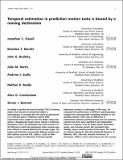Files in this item
Temporal estimation in prediction motion tasks is biased by a moving destination
Item metadata
| dc.contributor.author | Flavell, Jonathan C. | |
| dc.contributor.author | Barrett, Brendan T. | |
| dc.contributor.author | Buckley, John G. | |
| dc.contributor.author | Harris, Julie M. | |
| dc.contributor.author | Scally, Andrew J. | |
| dc.contributor.author | Beebe, Nathan B. | |
| dc.contributor.author | Cruickshank, Alice G. | |
| dc.contributor.author | Bennett, Simon J. | |
| dc.date.accessioned | 2018-03-01T13:30:05Z | |
| dc.date.available | 2018-03-01T13:30:05Z | |
| dc.date.issued | 2018-02-14 | |
| dc.identifier | 252430037 | |
| dc.identifier | 2ae5e6e6-c918-41d3-b947-389402718d98 | |
| dc.identifier | 85042219305 | |
| dc.identifier | 000426348600005 | |
| dc.identifier.citation | Flavell , J C , Barrett , B T , Buckley , J G , Harris , J M , Scally , A J , Beebe , N B , Cruickshank , A G & Bennett , S J 2018 , ' Temporal estimation in prediction motion tasks is biased by a moving destination ' , Journal of Vision , vol. 18 , no. 2 , 5 , pp. 1-11 . https://doi.org/10.1167/18.2.5 | en |
| dc.identifier.issn | 1534-7362 | |
| dc.identifier.other | ORCID: /0000-0002-3497-4503/work/46085836 | |
| dc.identifier.uri | https://hdl.handle.net/10023/12831 | |
| dc.description | This study was funded by the Biotechnology and Biological Sciences Research Council (grant references BB/J018163/1, BB/J016365/1, and BB/J018872/1). | en |
| dc.description.abstract | An ability to predict the time-to-contact (TTC) of moving objects that become momentarily hidden is advantageous in everyday life and could be particularly so in fast-ball sports. Prediction motion (PM) experiments have sought to test this ability using tasks where a disappearing target moves toward a stationary destination. Here, we developed two novel versions of the PM task in which the destination either moved away from (Chase) or toward (Attract) the moving target. The target and destination moved with different speeds such that collision occurred 750, 1,000 or 1,250 ms after target occlusion. To determine if domain-specific experience conveys an advantage in PM tasks, we compared the performance of different sporting groups ranging from internationally competing athletes to nonsporting controls. There was no difference in performance between sporting groups and non-sporting controls but there were significant and independent effects on response error by target speed, destination speed, and occlusion period. We simulated these findings using a revised version of the linear TTC model of response timing for PM tasks (Yakimoff, Bocheva, & Mitrania, 1987; Yakimoff, Mateeff, Ehrenstein, & Hohnsbein, 1993) in which retinal input from the moving destination biases the internal representation of the occluded target. This revision closely reproduced the observed patterns of response error and thus describes a means by which the brain might estimate TTC when the target and destination are in motion. | |
| dc.format.extent | 11 | |
| dc.format.extent | 535166 | |
| dc.language.iso | eng | |
| dc.relation.ispartof | Journal of Vision | en |
| dc.subject | Coincidence timing | en |
| dc.subject | Motion extrapolation | en |
| dc.subject | Prediction motion | en |
| dc.subject | Time to contact (TTC) | en |
| dc.subject | RE Ophthalmology | en |
| dc.subject | RC1200 Sports Medicine | en |
| dc.subject | Ophthalmology | en |
| dc.subject | Sensory Systems | en |
| dc.subject | DAS | en |
| dc.subject.lcc | RE | en |
| dc.subject.lcc | RC1200 | en |
| dc.title | Temporal estimation in prediction motion tasks is biased by a moving destination | en |
| dc.type | Journal article | en |
| dc.contributor.sponsor | BBSRC | en |
| dc.contributor.institution | University of St Andrews. School of Psychology and Neuroscience | en |
| dc.contributor.institution | University of St Andrews. Institute of Behavioural and Neural Sciences | en |
| dc.identifier.doi | 10.1167/18.2.5 | |
| dc.description.status | Peer reviewed | en |
| dc.identifier.grantnumber | BB/J016365/1 | en |
This item appears in the following Collection(s)
Items in the St Andrews Research Repository are protected by copyright, with all rights reserved, unless otherwise indicated.

